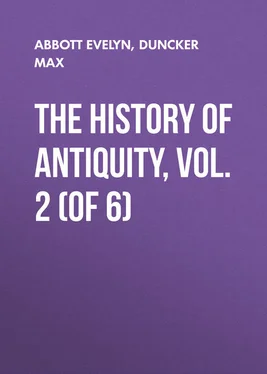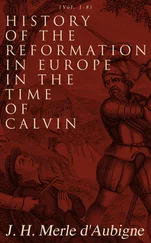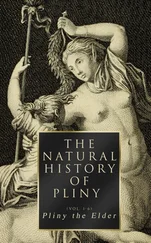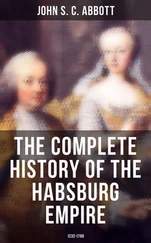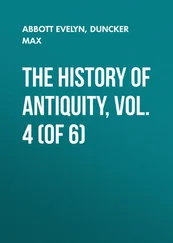Evelyn Abbott - The History of Antiquity, Vol. 2 (of 6)
Здесь есть возможность читать онлайн «Evelyn Abbott - The History of Antiquity, Vol. 2 (of 6)» — ознакомительный отрывок электронной книги совершенно бесплатно, а после прочтения отрывка купить полную версию. В некоторых случаях можно слушать аудио, скачать через торрент в формате fb2 и присутствует краткое содержание. Жанр: foreign_antique, foreign_prose, Историческая проза, на английском языке. Описание произведения, (предисловие) а так же отзывы посетителей доступны на портале библиотеки ЛибКат.
- Название:The History of Antiquity, Vol. 2 (of 6)
- Автор:
- Жанр:
- Год:неизвестен
- ISBN:нет данных
- Рейтинг книги:4 / 5. Голосов: 1
-
Избранное:Добавить в избранное
- Отзывы:
-
Ваша оценка:
- 80
- 1
- 2
- 3
- 4
- 5
The History of Antiquity, Vol. 2 (of 6): краткое содержание, описание и аннотация
Предлагаем к чтению аннотацию, описание, краткое содержание или предисловие (зависит от того, что написал сам автор книги «The History of Antiquity, Vol. 2 (of 6)»). Если вы не нашли необходимую информацию о книге — напишите в комментариях, мы постараемся отыскать её.
The History of Antiquity, Vol. 2 (of 6) — читать онлайн ознакомительный отрывок
Ниже представлен текст книги, разбитый по страницам. Система сохранения места последней прочитанной страницы, позволяет с удобством читать онлайн бесплатно книгу «The History of Antiquity, Vol. 2 (of 6)», без необходимости каждый раз заново искать на чём Вы остановились. Поставьте закладку, и сможете в любой момент перейти на страницу, на которой закончили чтение.
Интервал:
Закладка:
In memory of his achievements against the land of Nairi, Tiglath Pilesar also set up a special monument. On a rock at one of the sources of the Eastern Tigris near Karkar we see his image hewn in relief. He wears the tall cap or kidaris ; the hair and beard are long and curled; the robe falls in deep folds to the ancles. The inscription runs: "By the grace of Asshur, Samas and Bin, the great gods, my lords, I, Tiglath Pilesar, am ruler from the great sea of the west land ( mat acharri ) to the lake of the land of Nairi. Three times I have marched to the land of Nairi." 52 52 Vol. i. p. 519; E. Schrader, "Keilinschriften und A. T." s. 16.
The first subjugation of this district could not, therefore, have been complete.
As this monument proves, Tiglath Pilesar's campaigns could not have ended with the fifth year of his reign. From the synchronistic tablets we can ascertain that he had to undergo severe struggles with the Babylonians. Marduk-nadin-akh of Babylon invaded Assyria, crossed the Tigris, and the battle took place on the Lower Zab. In the next year, according to the same tablets, Tiglath Pilesar is said to have taken the border-fortresses of Babylon, Dur-Kurigalzu, Sippara, Babili and Upi (Opis ?). 53 53 Ménant, loc. cit. p. 51.
However this may be, Tiglath Pilesar in the end was at a disadvantage in his contest with the Babylonians. Sennacherib, king of Assyria, tells us, "The gods of the city Hekali, which Marduk-nadin-akh, king of the land of Accad, had taken in the time of Tiglath Pilesar, king of Asshur, and carried to Babylon 418 years previously, I have caused to be brought back again from Babylon and put up again in their place." A Babylonian tablet from the tenth year of Marduk-nadin-akh of Babylon appears to deal with loans on conquered Assyrian territory. 54 54 Vol. i. p. 263; Bavian Inscrip. 48-50; Ménant, "Annal." pp. 52, 236. Inscription on the black basalt-stone in Oppert et Ménant, "Documents juridiques," p. 98. Is the name of the witness (col. 2, 27), Sar-babil-assur-issu (p. 115), correctly explained by "The king of Babel has conquered Asshur"?
When Tiglath Pilesar ascended the throne about the year 1130 B.C. the empire of Assyria, as his inscriptions show, had not as yet made any extensive conquests beyond the circle of the native country. The Muskai, i. e. the Moschi, whom we have found on the north-western slopes of the Armenian mountains, against whom Tiglath Pilesar first fought, had forced their way, as the cylinders tell us, into the land of Kummukh. 55 55 Col. 1, 62.
As the inhabitants of the land of Kummukh are conquered on the Tigris and forced into it, while others escape over the Tigris and defend a fortified city on the further side of the river, as the land itself is then incorporated with Assyria, we must obviously look for it at no great distance to the north on both shores of the Upper Tigris. We shall hardly be in error, therefore, if we take this land to be the district afterwards called Gumathene, on the Tigris, which Ammianus describes as a fruitful and productive land, i. e. as the canton of Amida. 56 56 Ammian. Marcell. 18, 9.
The next conflicts of Tiglath Pilesar took place on the Lower Zab, i. e. at the south-eastern border of the Assyrian country. Further to the south, on the Zagrus, perhaps in the district of Chalonitis, or between the Lower Zab and the Adhim, or at any rate to the east, we must look for the land of Khumani and the land of Musri. The image at Karkar, Tiglath Pilesar's monument of victory, gives us information about the position of the land of Nairi. It comprises the mountain cantons between the Eastern Tigris and the upper course of the Great Zab, where that river traverses the land of Arrapachitis (Albak). The lake of the land of Nairi, to which the inscription of Karkar extends the rule of Tiglath Pilesar, and the upper sea from which auxiliaries come to the princes of the land of Nairi, are both, no doubt, Lake Van. The inhabitants of Nairi are not like those of the land of Kummukh, incorporated with Assyria, they have merely to pay a moderate tribute in horses and oxen. The campaign of Tiglath Pilesar against Karkamis (Karchemish) proves that the dominion of Assyria before his reign did not reach the Euphrates. He marches against the land of Aram and has then to fight with the army of Karchemish on this side, i. e. on the east side of the Euphrates; the results which he obtained on this campaign to the west of the Euphrates he does not himself rate very highly. We saw that in the end he remained at a disadvantage in his contest with Babylon. On the other hand, in campaigns which took place in years subsequent to the attempt against Karchemish, he must have forced his way to the west far beyond the Euphrates, in order to be able to boast on the monument at Karkar "that he ruled from the sea of Nairi as far as the great sea of the west land," i. e. to the Mediterranean. Hence we have to assume that he went forth from Karchemish westwards almost as far as the mouth of the Orontes. We should be more accurately informed on this matter if the fragment of an inscription on an obelisk beside an inscription of Assurnasirpal, who reigned more than 200 years after Tiglath Pilesar, could be referred to Tiglath Pilesar. The fragment speaks in the third person of the booty gained in hunting by a king, which is given in nearly the same totals as the results of Tiglath Pilesar's hunts on his cylinders. These represent him as slaying 120 lions and capturing 800. The fragment speaks of 120 and 800 lions, of Amsi killed in Charran on the Chabor, of Rim whom the king slew before the land of Chatti at the foot of Mount Labnani (Lebanon), of a crocodile ( nasukh ) which the king of Musri sent as a present. The hunter, it is said, ruled from the city of Babylon, in the land of Accad, as far as the land of the west ( mat acharri ). 57 57 Araziki cannot be taken for Aradus, the name of which city on the obelisk and in the inscriptions of Assurnasirpal, Shalmanesar, and elsewhere is Arvadu.
According to the inscriptions on the cylinders the land of Aram lies to the east of the Euphrates; the city of Karchemish lies on the west bank in the land of the Chatti. The Chatti are the Hittites of the Hebrews, the Cheta of the Egyptians. We found that the inscriptions of Sethos and Ramses II. extended the name of the Cheta as far as the Euphrates (I. 151, 152). But although the kingdom of the Hittites had fallen two centuries before Tiglath Pilesar crossed the Euphrates, the name still clung to this region, as the inscriptions of Tiglath Pilesar and his successors prove, more especially to the region from Hamath and Damascus as far as Lebanon. The land of the west ( mat acharri ) in the strict sense is, of course, to the Assyrians, from their point of view, the coast of Syria. Whatever successes Tiglath Pilesar may have gained in this direction, they were of a transitory nature.
The first of his sons to succeed him was Assur-bel-kala, whose reign we may fix in the years 1100-1080 B.C. With three successive kings of Babylon, Marduk-sapik-kullat, Saduni (?), and Nebu-zikir-iskun, he came into contact, peaceful or hostile. With the first he made a treaty of peace, with Saduni he carried on war, with Nebu-zikir-iskun he again concluded a peace, which fixed the borders. This was confirmed by intermarriage; 58 58 Sayce, "Records," 3, 33; Ménant, "Annal." p. 53; "Babylone," pp. 129, 130.
Assur-bel-kala married his daughter to Nebu-zikir-iskun, while the latter gave his daughter to Assur-bel-kala. Of the exploits of his successor, Samsi-Bin II. (1080-1060 B.C.), a second son of Tiglath Pilesar, we have no account. 59 59 According to G. Smith ("Discov." p. 91, 252) this Samsi-Bin II. restored the temple of Istar at Nineveh which Samsi-Bin I. had built (above, p. 3).
We cannot maintain with certainty whether Assur-rab-amar, of whom Shalmanesar II. tells us that he lost two cities on the Euphrates which Tiglath Pilesar had taken, 60 60 Inscription of Kurkh, "Records of the Past," 3, 93; Ménant, "Annal." p. 55.
was the direct successor of Samsi-Bin.
Интервал:
Закладка:
Похожие книги на «The History of Antiquity, Vol. 2 (of 6)»
Представляем Вашему вниманию похожие книги на «The History of Antiquity, Vol. 2 (of 6)» списком для выбора. Мы отобрали схожую по названию и смыслу литературу в надежде предоставить читателям больше вариантов отыскать новые, интересные, ещё непрочитанные произведения.
Обсуждение, отзывы о книге «The History of Antiquity, Vol. 2 (of 6)» и просто собственные мнения читателей. Оставьте ваши комментарии, напишите, что Вы думаете о произведении, его смысле или главных героях. Укажите что конкретно понравилось, а что нет, и почему Вы так считаете.
